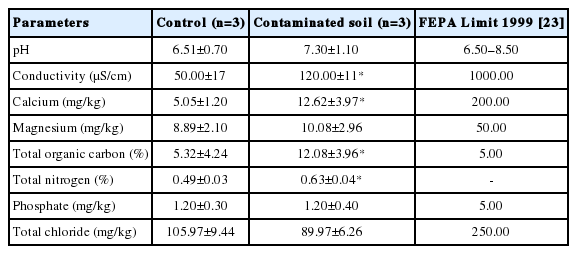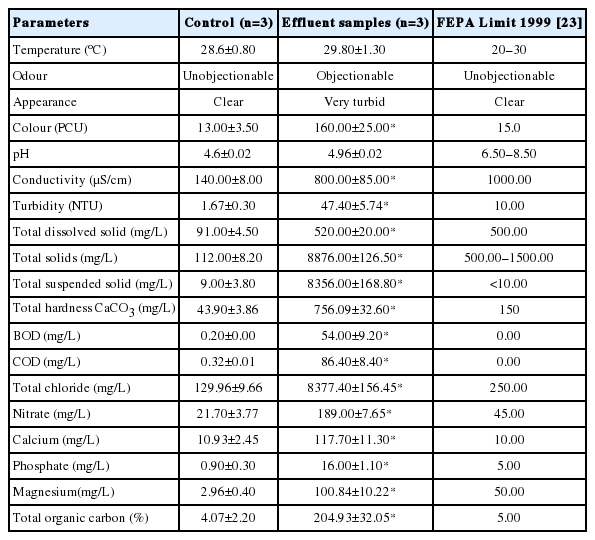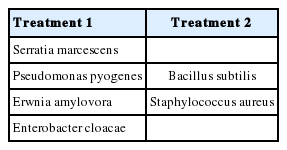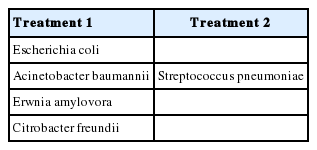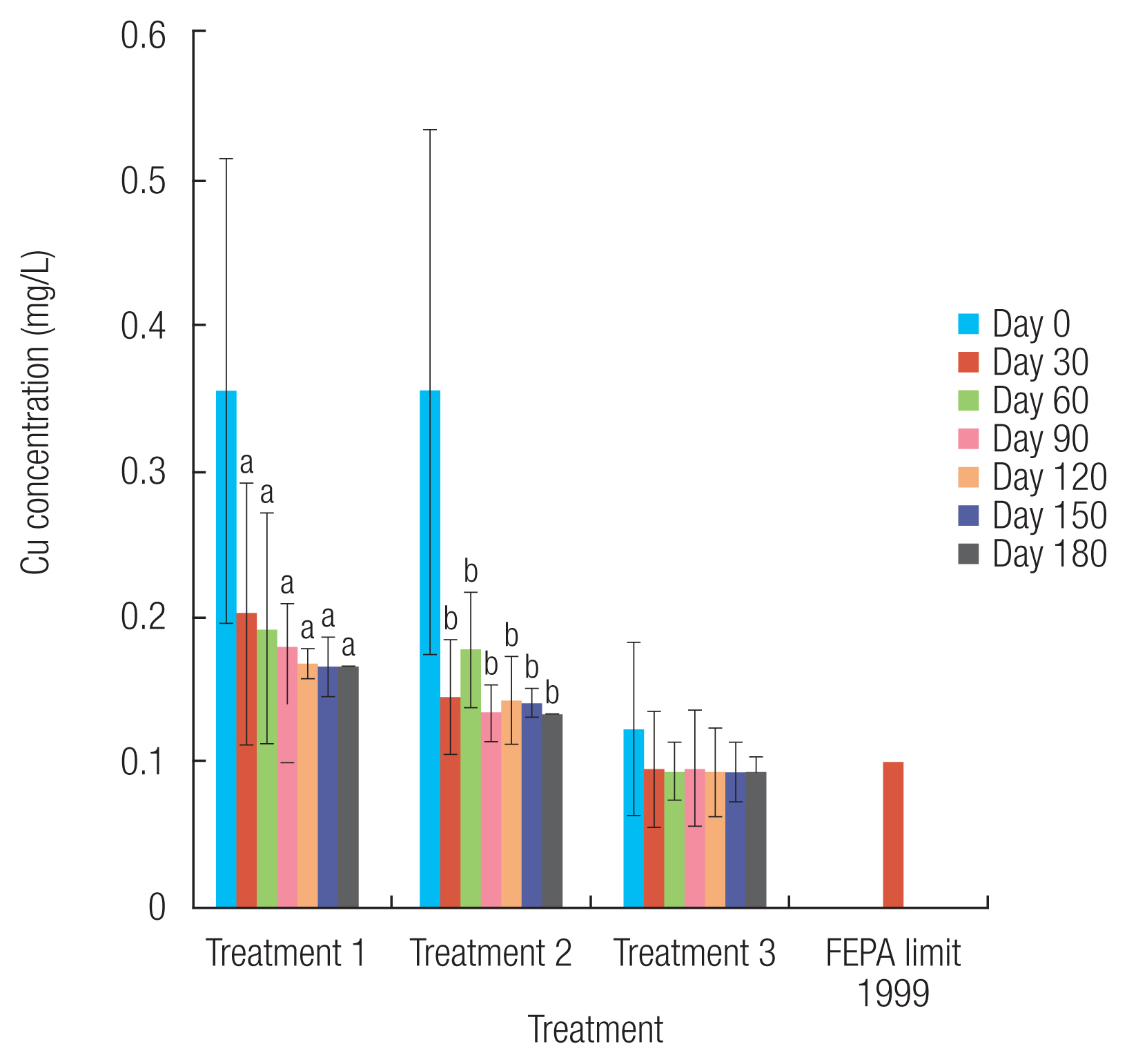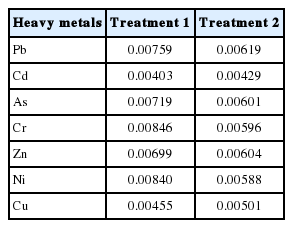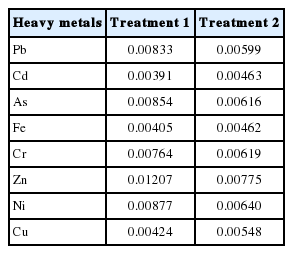Bacterial remediation of heavy metal polluted soil and effluent from paper mill industry
Article information
Abstract
Bacterial remediation of heavy metal polluted soil and effluent from paper mill was investigated using standard analytical methods. The paper mill was visited for 6 months at interval of 30 days to collect soil and effluent samples for the analysis. The pH of soil was slightly alkaline while effluent was acidic. There was a significant increase (P<0.05) in total organic carbon (TOC) of soil; and turbidity, biochemical oxygen demand (BOD), chemical oxygen demand (COD) and TOC of effluent when compared to control. Bacteria isolated from the samples were grouped into two and used to remediate eight heavy metals. The remediation experiment consists of three treatments; Treatment 1 (treated with proteobacteria), Treatment 2 (treated with non-proteobacteria) and Treatment 3 (without bacteria) (control experiment). Result of the remediation study showed that there was a significant decrease (P<0.05) in Treatment 1 and Treatment 2 of all the heavy metals in soil and effluent samples from day 30–180 when compared to day 0. The rate of removal of heavy metals in soil was highest in Treatment 1 for chromium (Cr; 0.00846 day−1) and lowest in Treatment 1 for cadmium (Cd; 0.00403 day−1) while the rate of removal in effluent was highest in Treatment 1 for zinc (Zn; 0.01207 day−1) and lowest in Treatment 1 for Cd (0.00391 day−1). It was concluded that bacteria isolated from soil and effluent samples were capable of remediating the concentration of Pb, arsenic (As), Cr, Zn and nickel (Ni) heavy metals.
Introduction
Heavy metals exist in concentrations that vary in nature or as a direct consequence of the activities of man within the ecosystem [1]. In recent times, anthropogenic activities of man introduced some of these heavy metals into the environmental soil and water bodies beyond acceptable limits [2]. According to Awofolu [3], heavy metals are translocated through food chain; however they could be toxic at certain concentrations owing to their non-degradable nature. The limiting factor about heavy metals is their inability to be broken down and their toxicity to living organisms at stipulated levels. To ensure the general safety of the environment to man and living organisms, polluted soil and water bodies should be remediated to rid of heavy metals and other minute elements [4].
There are numerous techniques that ranges from oxidation/reduction, precipitation, evaporation, filtration, ion exchange, electrochemical and osmotic methods utilized to take away heavy metals from contaminated environment [5]. The major shortfall of the aforementioned techniques is their inability to remove heavy metals at concentrations below 100 mg/L [6] and the solubility of salts formed by these heavy metals [7] coupled with their expensive and fluctuating nature. To eliminate these shortcomings, the use of biological methods such as bioremediation using microbes and plants has emerge as an effective and safe technique for the remediation of soil and water bodies contaminated with heavy metal [8].
Bioremediation is an innovative technology that has gained wide recognition for elimination of heavy metals from contaminated soil and water bodies. Owing to the variation in survival strategies by microbes to contaminated environments, these microbes resort to different means of adaption such as biosorption, biodigestion, bioaccumulation, biomineralization and biotransformation to detoxify heavy metals either in-situ or ex-situ [4,9–12]. The uptake of heavy metals by microbes can either be by adsorption (passive) or bioaccumulation (active) [13]. However, presence of heavy metals in the soil and water bodies brings about certain modifications in the microbial community [14] which can be expressed via blockage and inhibition of vital functional moieties, modifications of active molecules or displacement of metal [4,15]. Bacterial cell wall consists of polysaccharides, proteins and lipids which offer binding capacity to amino, phosphate, carboxylate and hydroxyl groups of heavy metals [4,16].
Methods
Sample collection
The method of Neboh et al. [17] was employed for collection of soil and effluent sample. The paper mill was visited for 6 months at interval of 30 days to collect samples during the period and samples were collected in the morning hours during the peak activities between 9:00–11:00 am. The soil samples were excavated at 45 cm depth for optimal bacteria action using a soil auger and collected with the aid of aluminum foils for organic chemical analysis while effluent samples were collected using 500 mL sterilized Pyrex glass bottles with tight screw stoppers. All samples were replicated thrice, transported to the laboratory in ice jackets and processed within 6 hours after sampling. The bacterial species was isolated and heavy metals concentration and potential of the isolated bacteria to bioremediate contaminated soil and effluent discharge were analyzed.
Isolation of bacterial and grouping
Isolation
For isolation of bacteria in soil samples, exactly 10 g of the soil was mixed in 90 mL deionized water while for bacteria isolation in effluent samples, 10 mL of the effluent were diluted in 90 mL of deionized water [18]. The mixture was placed in an automated orbital shaker (Searchtech Nig Ltd) at 180 rpm for 3 hours to shake vigorously, and the resulting suspension was subjected to 10 times serial dilution. Aliquots (0.1 mL) each of (10−2, 10−3, 10−4 or 10−5) of the test tubes were dispensed under aseptic condition into nutrient agar plate by spread plate technique and incubated at 37 °C for 24 hours on the incubator. After incubation, developed colonies were further sub-cultured to obtain pure samples before identification and grouping.
Soil and effluent digestion for heavy metal analysis in paper mill
Digestion and analysis of soil samples
Ten grams of the soil sample was placed into 50 mL beaker and 5 mL of concentrated aqua-regia (HNO3:HCl:H2SO4 in the ratio of 3:2:1) was added. The mixture in the beakers were covered with watch glass and boiled on a hot plate at 125°C for 2 hours. A small portion of aqua-regia was added to the solution and it appeared light color and clear. The beaker wall and watch glass were then washed with deionized water and the samples was filtered to remove insoluble materials that could clog the atomizer. Then, the digest was cooled at room temperature and filtered through a Whatman Grade 1 filter paper in 50 mL volumetric flask. The volume of the filtrate was made up to 50 mL with deionized water.
Digestion of effluent sample
5 mL of HNO3 was added to 50 mL of water sample and digested by heating on a plate to obtain a colorless solution. The digest was cooled down and then filtered into a 100 mL volumetric flask. The volume of the digested water sample was made up to 100 mL with distilled water [22].
A control sample was digested by transferring 50 mL of deionized water into a beaker and digesting as described above for blank correction. Heavy metals, Cu2+ (324 nm), Zn2+ (213 nm), Fe2+, (248 nm), Cr2+ (357 nm), Cd (228 nm), As (193 nm), Ni (232 nm), and Pb2+ (283 nm) were determined directly at the stated wavelengths on each final solution using classical Atomic Absorption Spectroscopy (Model: PG-990 AAS) [22]. Results obtained were compared with Federal Environmental Protection Agency (FEPA) [23] Standard.
Formulation of microbial consortium for bioremediation of heavy metals in contaminated soil and effluent
The utilized microbial consortia in this study comprised isolated strains using the method stated above. First, individual strains were grown in Nutrient Agar for 2 days at 33°C, inoculated to Nutrient Broth and grown to achieve stationary phase in an automated orbital shaker at 150 rpm. Upon achieving a growth of 1.3 ABS at a wavelength of 600 nm, the individual strains were pooled out in equal amounts [9].
Experimental design
Bioremediation study was carried out using the method of Fauziah et al. [18] Contaminated (within the paper mill environment) and uncontaminated (a control point outside the paper mill polluted site) soil and water samples were utilized for the bioremediation study. The experiment consists of three treatments; Treatment 1 treated with proteobacteria, Treatment 2 treated with non-proteobacteria and Treatment 3 without bacteria (control experiment). A 2 g of contaminated soil/2 mL of effluent was amended with 10% (v/v) of microbial inoculum. Each treatment was made up of 3×109 CFu/mL of inoculums. The experimental set up lasted for 6 months and readings taken at interval of 30 days. Water was added regularly to keep the moisture level at 60–65%. The process was replicated thrice for all treatments.
Rate equation for the removal of heavy metal
The rate of heavy metal uptake per day was obtained according to the equation of first order kinetic models [18]:
where K is the constant for first order rate of heavy metal
uptake per day, t is time (days), C is concentration of residual metal in the soil per effluent (L/kg), and C0 is initial concentration of metal in the soil/effluent (L/kg)
Method of Data analysis
Data were analyzed using Statistical package for Biological and Social Sciences (SPSS) Incident 21.0 Software. Descriptive and one-way analysis of variance (ANOVA) for comparison was carried out and results expressed as mean±standard deviation.
Results and Discussion
Analysis of Physicochemical Parameters of Contaminated Soil and Effluent Samples
The physicochemical analyses of contaminated and effluent samples are shown in Tables 1 and 2, respectively.
Biochemical test
The biochemical identification of bacteria isolated from polluted soil and effluent samples are shown in Tables 3 and 4, respectively.
Bacteria grouping
The groupings of bacteria for remediation in soil and effluent are shown in Tables 5 and 6, respectively.
Bioremediation of heavy metals in contaminated soil from paper mill industry
The remediation of heavy metals in contaminated soil is shown in Table 7.
Bioremediation of heavy metals in effluent from paper mill industry
The remediation of heavy metals in effluent discharge is shown in Figures 1–8.
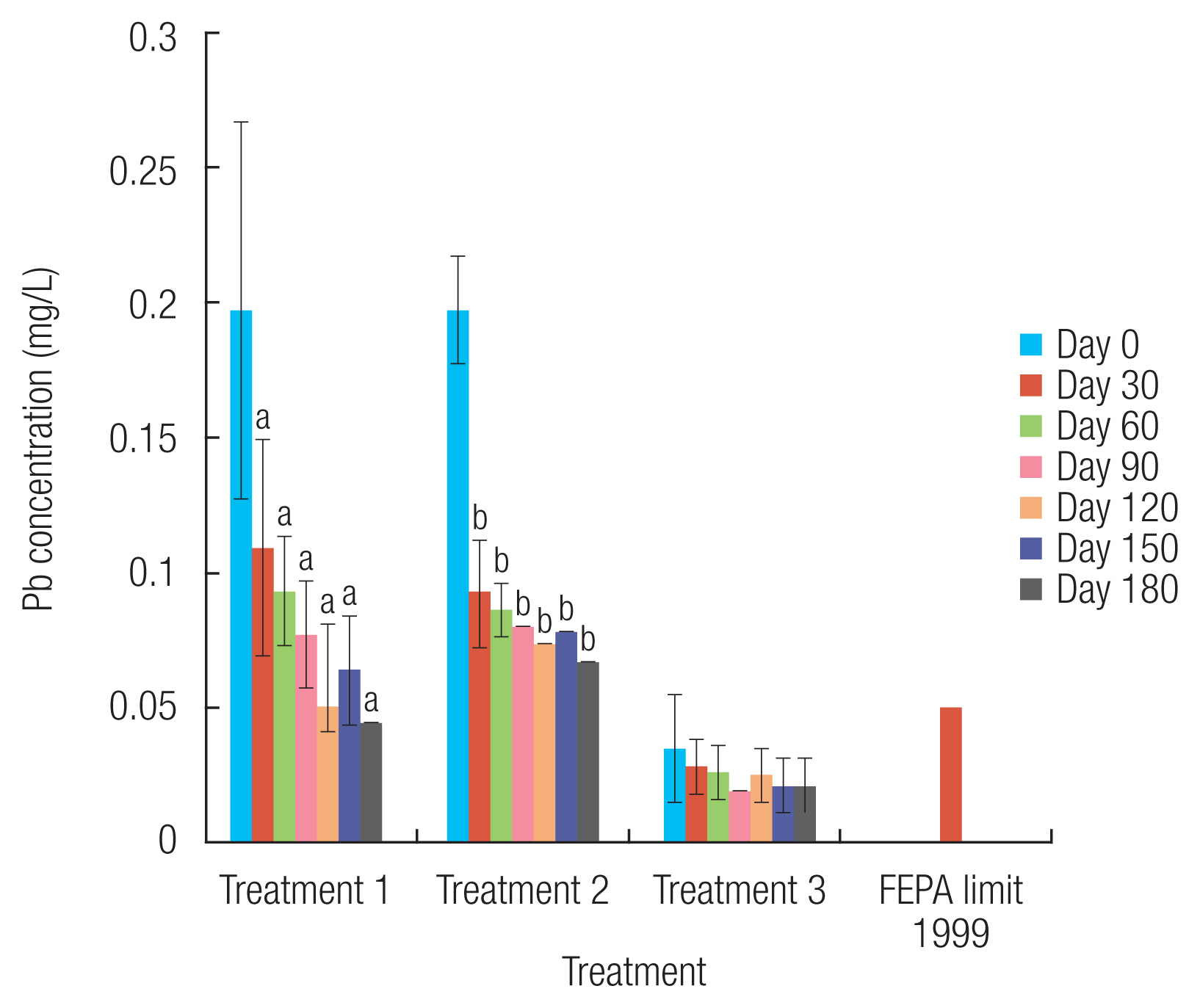
Concentration of lead (Pb) in effluent within the time duration with different treatment (n=3). *p<0.05.
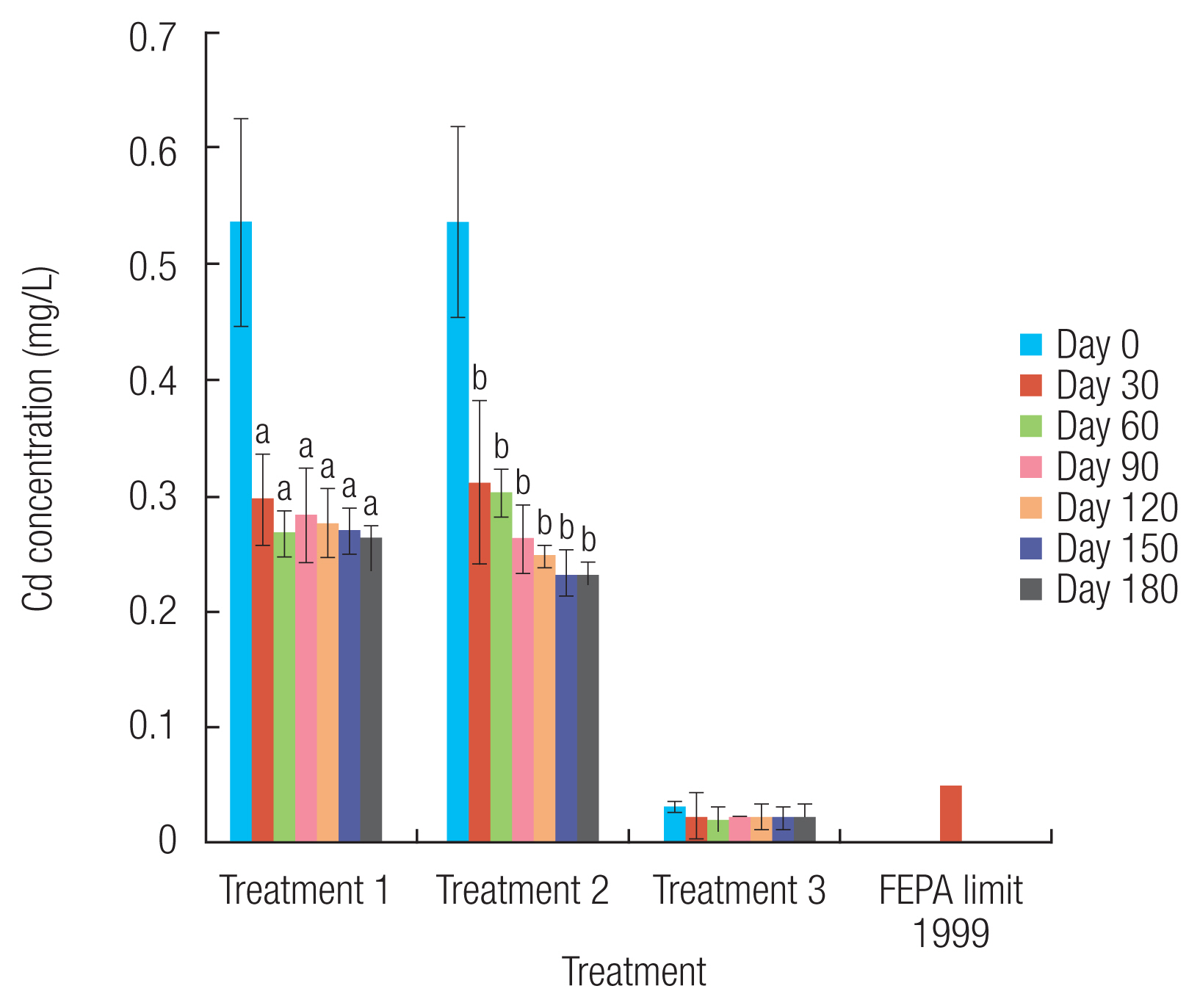
Concentration of cadmium (Cd) in effluent within the time duration with different treatment (n=3). *p<0.05.
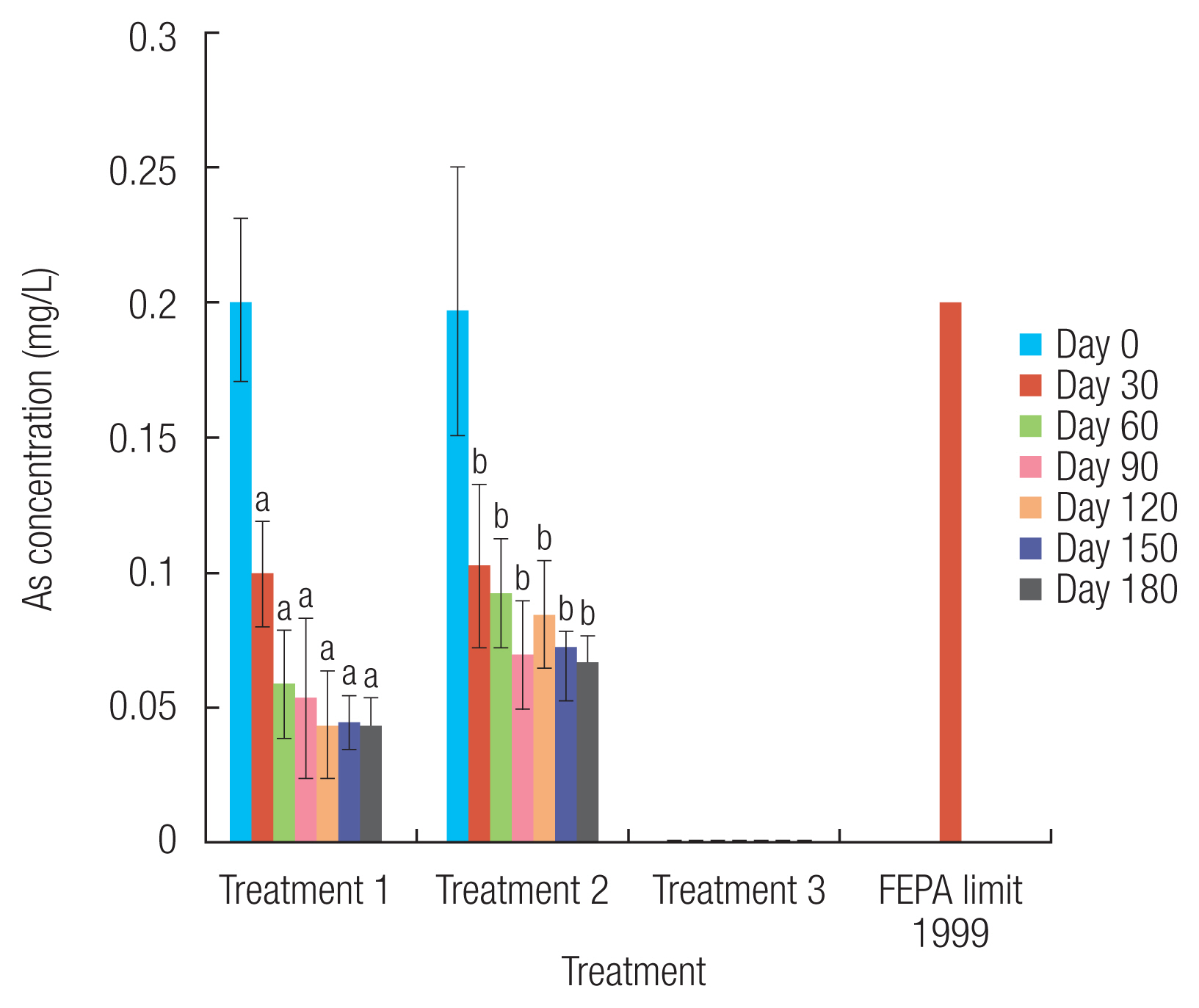
Concentration of arsenic (As) in effluent within the time duration with different treatment (n=3). *p<0.05
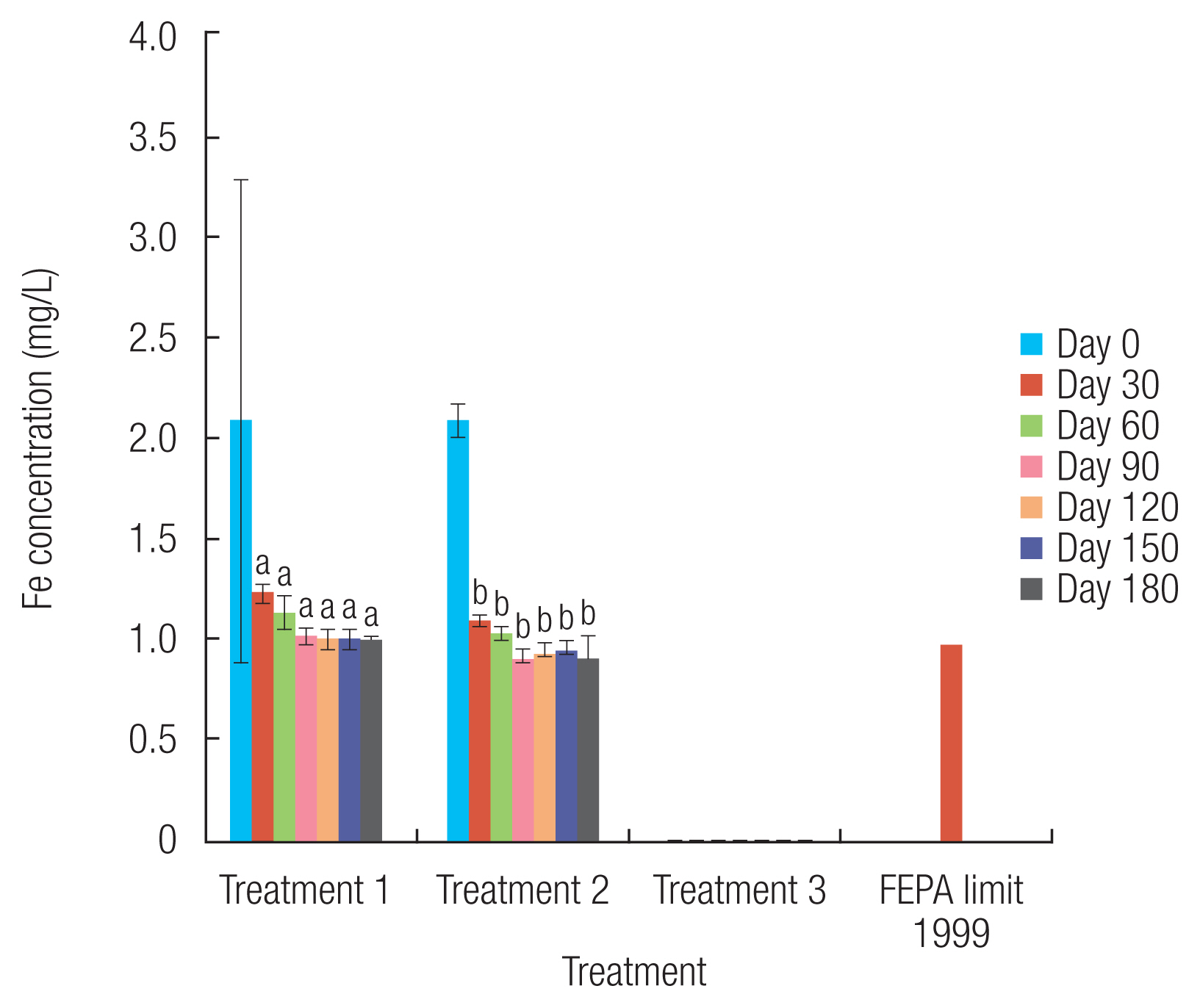
Concentration of iron (Fe) in effluent within the time duration with different treatment (n=3). *p<0.05.

Concentration of chromium (Cr) in effluent within the time duration with different treatment. (n=3). *p<0.05.
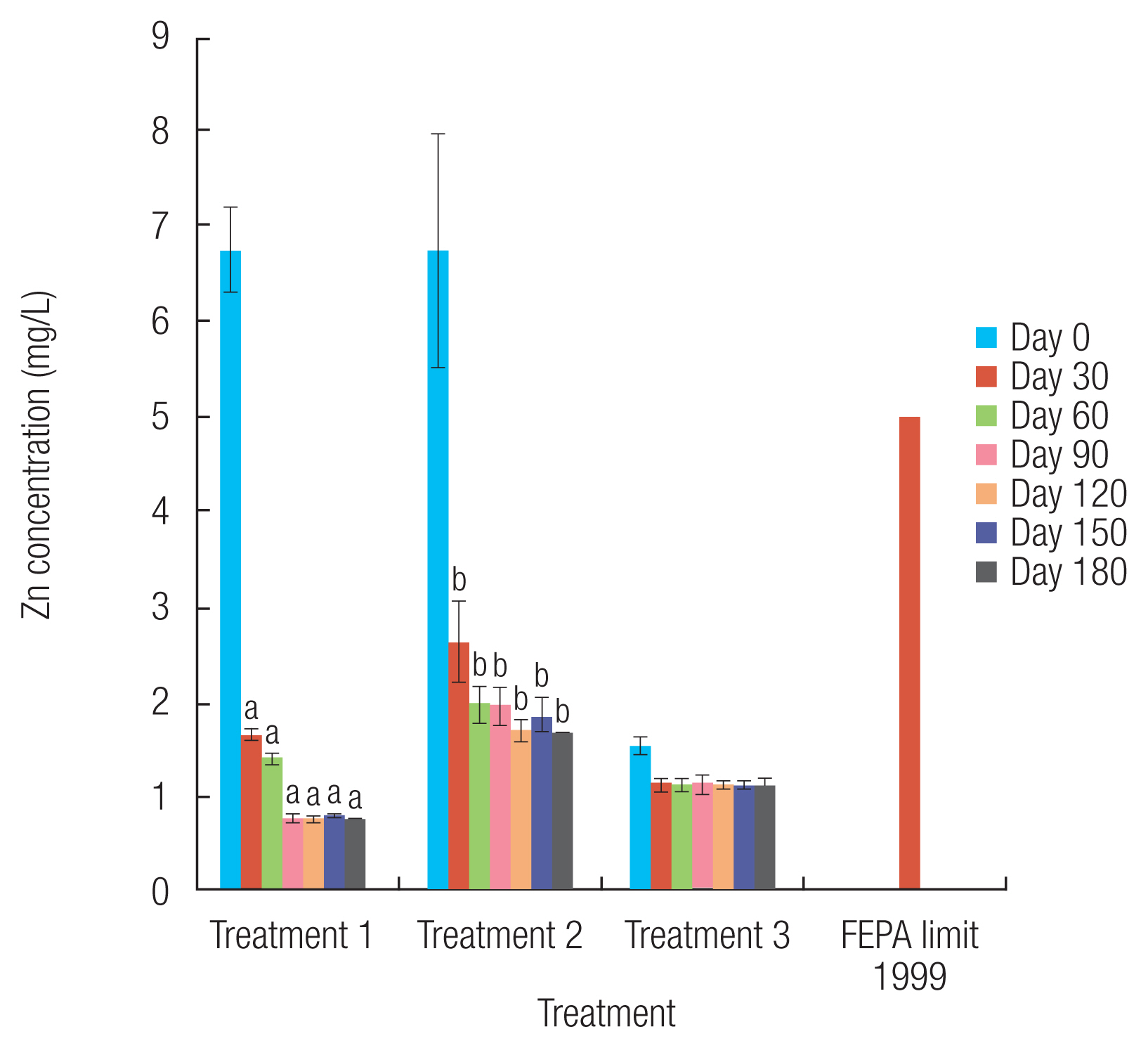
Concentration of zinc (Zn) in effluent within the time duration with different treatment (n=3). *p<0.05.
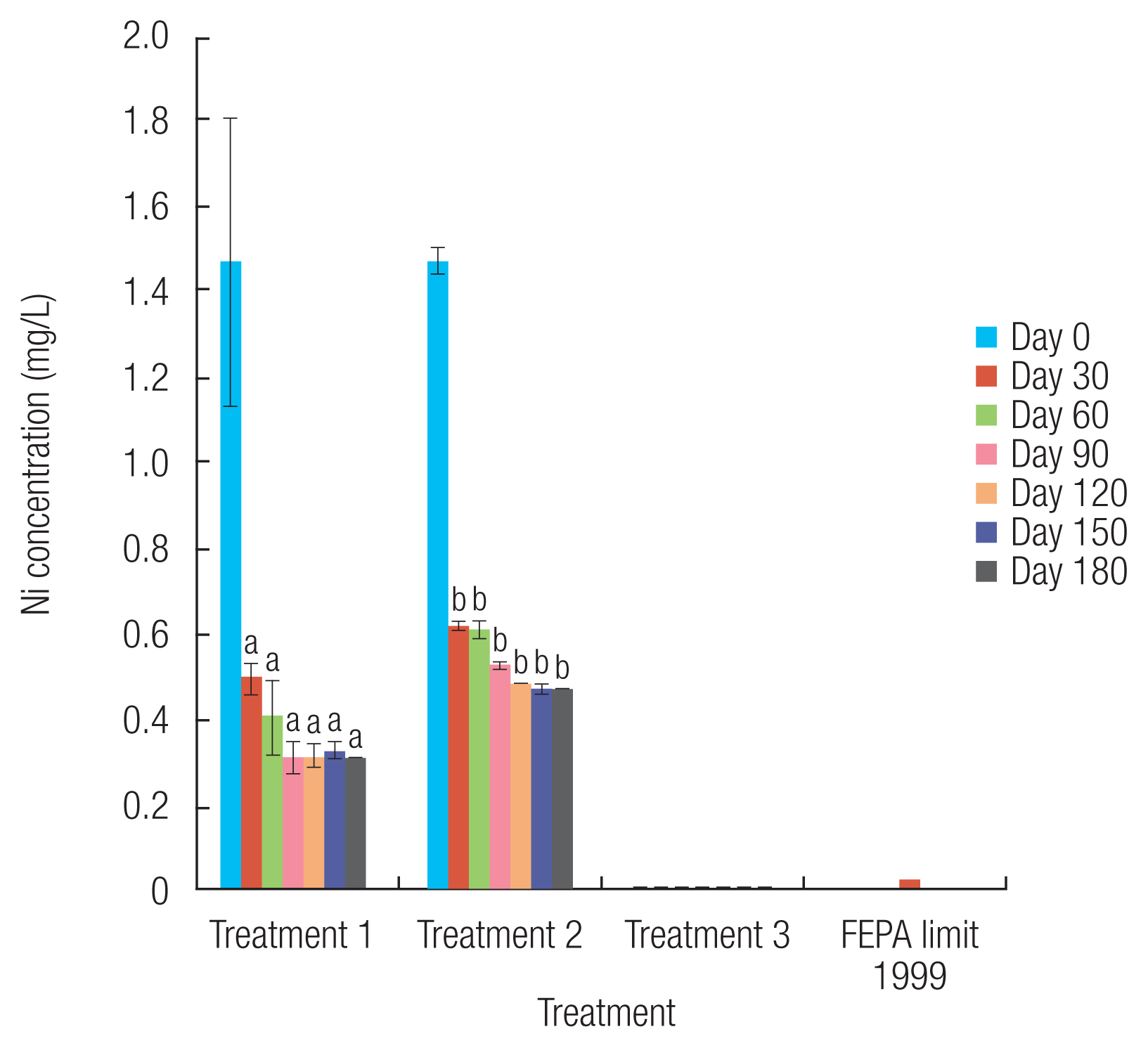
Concentration of nickel (Ni) in effluent within the time duration with different treatment (n=3). *p<0.05.
Rate of heavy metals removal from paper mill contaminated soil and effluent
The rate of removal of heavy metals from soil and effluent samples are shown in Tables 8 and 9.
Table 1 contains the results of the physicochemical parameters of contaminated soil sample. There was no significant difference (P<0.05) in pH and phosphate of the contaminated soil sample when compared to the control. However, the pH of contaminated soil was slightly alkaline. There was a significant increase (P<0.05) in the conductivity, calcium, total organic carbon (TOC) and total nitrogen content when compared to control. The TOC was higher than FEPA [23] limit. Due to limited research on the physicochemical analysis of soil samples from paper mill industries, comparisons were made to the physicochemical parameters of tannery industry and other closely related industries. The obtained pH values were similar to the findings of Rabah and Ibrahim [24] but dissimilar to Oluyemi [25] while the concentration of calcium and magnesium obtained were higher than a literature [24] on the physicochemical characterization of soils laden with tannery effluents. The TOC and total nitrogen obtained in the contaminated soil sample were lower than values recorded in Olyuemi [25].
Table 2 expressed the results of the physicochemical parameters of effluent sample. The temperature of the effluent discharge was within acceptable range when compared to the limit of FEPA [23]. It was observed that the total suspended solids (TSS), phosphate, colour change, conductivity, turbidity, total dissolved solids, biochemical oxygen demand (BOD), chemical oxygen demand (COD), nitrate and TOC were significantly higher (P<0.05) in the effluent than both the control and the FEPA limit [23]; however the pH was lower in the effluent discharge. The acidic pH value recorded do not fall within the recommended range which is suitable for aquatic life, though the pH value recorded here is similar to findings of Suryan and Ahluwalia [26] in their work on the maximum adsorption affinity during the biosorption of heavy metals by paper mill waste from aqueous solution. pH expresses the quality of water and shows the extent of pollution [27], thus the acidic values at the discharge point suggests that the effluents could be harmful and does not support aquatic life as most of their metabolic activities are pH dependent [28]. Temperature is an essential factor as it controls behavioural characteristics of organisms, solubility of gases and salts in water [29]. The mean temperature value was within the range for a tropical aquatic system (<40°C) and within FEPA standard [23]. This could be because the effluent was not from thermal pollution or a power plant [30].
High BOD and COD values obtained could be attributed to the high organic matter in the effluent and this connotes toxicity of the effluent discharge [31]. The BOD and COD values obtained in this study were lower than values obtained by Dauda et al. [32]. The greater the BOD, the more rapidly oxygen is depleted in the stream. Both COD and BOD values are a measure of the relative oxygen that is lost from contaminated waste [33].
At high turbidity levels, water loses its ability to support diversity of aquatic organism due to obstruction of light [34]. The high turbid nature of the effluent implies low penetration of light which does not support life and accounts for the corresponding increase in color and conductivity of the effluent.
The TSS level was higher when compared to results obtained by Dauda et al. [32]. Such elevated value for TSS might be attributed to the high organic load and total dissolved solid wastes originating from industrial waste generation. High TSS obstructs light from getting underneath vegetation which slows photosynthesis [35].
Nitrate concentration expresses the quantity of organic matter present mostly as a result of breakdown of protein and nitrogenous compounds [36]. Nitrate at toxic limits cannot be acted upon in the human intestine hence obstructs movement in the red blood cells [36]. When compared with the works of Oladeji [37] and Umunnakwe [38], the concentration of nitrates obtained here was higher.
Biochemical identification revealed that Pseudomonas, Staphylococcus, Erwnia, Enterobacter, Bacillus and Serratia species (Table 3) were found in polluted soil and Acinobacter, Citrobacter, Erwnia, Escherichia coli and Streptococcus species (Table 4) were found in the effluent.
The bioremediation studies of the removal of the individual heavy metal in the contaminated soil and effluent samples from paper mill industry for six months are shown in Table 7 and Figures 1–8, respectively. Microorganisms, through different influx and efflux methods alongside metal complexation, are able to reduce and contain heavy metals in soil and effluent samples. Bacteria obtained from contaminated soil and effluent samples were grouped into proteobacteria (Treatment 1) and non-proteobacteria (Treatment 2) according to their gram staining for the bioremediation experiment set up (Tables 5, 6) while the third group (Treatment 3) had no bacteria. Proteobacteria are gram negative while non-proteobacteria are gram positive [18]. The bacteria were grouped to enhance metabolic activity of the microbes and increase their affinity to heavy metals [39]. It aids their electrostatic interaction, exchange of ions and redox processes [40,41]. Furthermore, grouping of bacteria increases their stability and makes them ideal for field application [42,43].
Table 7 showed the heavy metal remediation on soil samples across time with different treatments. Treatment 1 reduced 74.5% of extractable (Pb) from the contaminated soil while Treatment 2 reduced Pb concentration by 67.2%. Treatment 2 (53.8%) had a higher cadmium (Cd) removal from the contaminated soil than Treatment 1 (51.6%). Arsenic (As) concentration in soil from was better remediated with Treatment 1 (72.6%) than Treatment 2 (66.1%). Treatment 1 (78.2%) had a higher chromium (Cr) removal from the contaminated soil than Treatment 2 (65.8%). Treatment 1 (71.6%) had a higher zinc (Zn) removal than Treatment 2 (66.3%) from the contaminated soil. Treatment 1 removed 78.1% of the nickel (Ni) from the contaminated soil while Treatment 2 removed 65.3%. Treatment 2 (59.4%) had a higher copper (Cu) removal from the contaminated soil than Treatment 1 (55.9%). Iron (Fe) was not detected in the soil sample.
There was a significant decrease (P<0.05) in the concentrations of all the heavy metals from day 30–180 by Treatments 1 and 2 when compared to their respective concentrations at day 0 while Treatment 3 was unchanged. The significant decrease observed in this study might imply that the bacteria have an undiscovered and unexplored potential to remediate heavy metals in the soil.
Furthermore, Figures 1–8 showed the remediation of heavy metals in effluent samples from day 0–180 with the different treatments. There was a significant decrease (p<0.05) in the concentrations of all the heavy metals from day 30–180 by Treatments 1 and 2 when compared to their respective concentrations at day 0 while Treatment 3 remained unchanged. Treatment 1 (77.7%) demonstrated higher removal for Pb than Treatment 2 (65.8%) after remediation (Figure 1). Treatment 1 removed 50.5% of the Cd while Treatment 2 removed 56.4% from the effluent samples (Figure 2). Treatment 1 (78.5%) had a higher As removal than Treatment 2 (67.2%) (Figure 3). Higher removal activities were observed with Treatment 2 (56.4%) than Treatment 1 (51.8%) for Fe (Figure 4). Treatment 1 removed 74.7% of Cr while Treatment 2 removed 67.3% (Figure 5). Figure 6 showed that Treatment 1 (88.6%) had a higher Zn removal from the effluent sample than Treatment 2 (75.2%). Treatment 1 (79.4%) had a better Ni metal removal than Treatment 2 (68.4%) (Figure 7) while Figure 8 expressed higher removal potential of Cu by Treatment 1 (53.4%) than Treatment 2 (62.7%) from the effluent samples. The removal activities for As, Zn and Ni in soil and effluent samples were very high when compared to similar study by Fauziah et al. [18] who investigated remediation of heavy metal contaminated soil using potential microbe isolated from a closed dump site. Treatment 1 (Proteobacteria group) generally had higher remediation tendency and appeared to be associated positively with heavy metal removal.
The variation in the removal of heavy metal by the individual treatment groups may be attributed to the fact that certain microbes have higher affinity and sensitivity to a particular heavy metal than another. Microbiological processes in the soil can either solubilize metals (i.e., increase their bioavailability and potential toxicity), or immobilize them, (i.e. decrease the bioavailability of metals). These biotransformation processes are important components of biogeochemical cycles of metals exploited in bioremediation of heavy metal contaminated samples [9].
According to Kuddus et al. [44], bioremediation successfully takes place when 65% or more of the heavy metals are removed from the original molecule. From this study, it implies that the remediation of Pb, As, Cr, Zn, and Ni in soil and effluent samples in this study was very successful.
The rate of removal of selected heavy metals from soil and effluent samples are shown in Tables 8 and 9. Table 8 showed that for Treatment 1, Cr (0.00846 day−1) had the highest removal rate, followed by Ni (0.00840 day−1), while Cd (0.00403 day−1) had the least removal rate. For Treatment 2, Pb (0.00619 day−1) had the highest removal rate, followed by Zn (0.00604 day−1) while Cd (0.00429 day−1) had the least removal rate. Similarly, Zn had the highest removal rate for Treatment 1 (0.01207 day-1) and Treatment 2 (0.00775 day−1), followed by Ni Treatment 1 (0.00877 day−1) and Treatment 2 (0.00640 day−1) while Cd Treatment 1 (0.00391 day−1) and Treatment 2 (0.00463 day−1) had the least removal rate (Table 9). Generally, Treatment 1 had a higher rate of removal for Pb, As, Cr, Zn, and Ni in contaminated soil and effluent samples than Treatment 2. This implies that proteobacteria has higher tendency to remediate most heavy metals in contaminated soil and effluent. The findings from this study on removal rate for heavy metals are similar to other studies on the bioremediation of heavy metal contaminated areas [18,45,46] but dissimilar to study by Suryan [26].
Conclusion
This study has shown that some bacteria have the tendency to survive and transform heavy metals to be less toxic. Though, the soil and effluent discharge were not pretreated, this study has showed that bacteria isolated from paper mill were capable of sorbing the highly toxic heavy metal accumulation in a manner that was time dependent. Heavy metals, Pb, As, Cr, Zn, and Ni, in soil and effluent samples were successfully remediated with proteobacteria having a higher remediating potential than non-proteobacteria. This may possibly be the most suitable waste management process in paper mills. The application of this method in a continuous system, microbial bioaccumulation of heavy metals and molecular characterization are among the future research plan.
Notes
Conflict of interest
The authors declare no conflict of interest.
CRediT author statement
ULN: Conceptualization, Methodology, Software, Validation, Investigation, Resources, Writing-Original, Writing - Review & Editing, Visualization, Supervision, Project Administration, Funding Acquisition; PIA: Methodology, Software, Formal analysis, Investigation, Writing-Original, Writing-Review & Editing, Visualization, Project Administration; BEBN: Conceptualization, Validation, Writing-Review & Editing, Visualization, Supervision.

